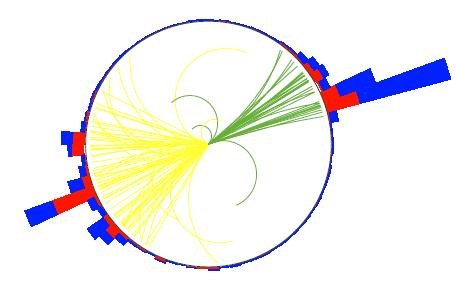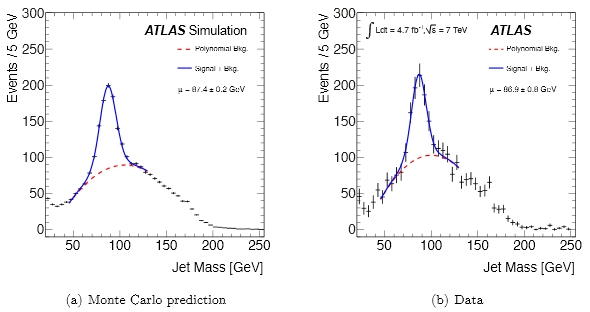The paper is very technical, as it should, and only readers familiar with jet reconstruction techniques may benefit from a careful look at it. However, here I believe it is interesting to summarize what the whole thing is about, in as simple terms as possible. Before I try to explain that, I feel it is better to first recall some basic facts about jet production at hadron colliders.
The genesis of jets
Jets are collimated sprays of particles that are emitted from the interaction point when a energetic parton (a quark or a gluon) is kicked out by the hard collision. The picture below, showing the reconstructed tracks produced by two back-to-back jets (in this case, originated by a simulated decay of a heavy Z' boson (a fictitious particle!) decaying into two top quarks - a process which is relevant to the discussion below) clarifies what I mean: in the picture the detector is shown as a circular section orthogonal to the beams; the inner tracker inside the circle is surrounded by calorimeters which measure all particles by having them interact with heavy nuclear matter; the large and small energy deposits in the calorimeter are shown by bars of different extension. The sprays of tracks exiting toward the left and toward the right are two jets; the left one is wider, and within it one might glimpse even by eye at some substructure... But let's leave that for later for the moment.

What happens in the creation of a jet is that the quark (let's pick a quark for simplicity) loses energy as it travels away from the proton that once contained it, because a string of colour pulls back with a strength proportional to its extension. ("Colour" is the charge of the strong nuclear force: all quarks and gluons are coloured. The peculiarity of colour is that only particles with zero net colour can be formed: so quarks only exist within hadrons, where they combine in colourless pairs or triplets.)
The colour string can break up when its potential energy exceeds the energy needed to produce a quark-antiquark pair: as a result, to the original quark a new quark-antiquark pair is added, which more or less shares with it the direction of motion.
Note that it is not always the case that the quark or gluon originating a jet existed in the colliding bodies before the interaction: sometimes it is instead materialized by the conversion into matter of the collision energy, or from the decay of a heavy object (a top quark or a W or Z boson, or even a Higgs boson!). In such cases we only get a quark if we also get an antiquark with it; but we may get an arbitrary number of gluons (but more than one!).
Another way to describe the loss of energy of the original quark is that as it decelerates, it "radiates" gluons - which are themselves coloured; gluons can in turn "split" into quark-antiquark pairs. Gluon radiation is a process analogous to electromagnetic radiation: in both cases, a moving charge can be the source of the emission; only, here we are talking of the colour charge and not the ordinary one!
At the end of the complex chain of reactions creating a shower of quarks and gluons, these recombine into colourless hadrons. This phase is called "hadronization". The produced particles which end up traveling almost collimated, collectively carrying the total energy of the quark that originated the shower. Note that none of the above processes is directly observable, because they take place in the course of the first billionth of billionth of a second after the collision; what we observe is instead the final product, the hadronic jet.
Hadronic jets were first observed in the seventies, in collisions of electrons with positrons that created quark-antiquark pairs; in fact, that was one of the pieces of evidence that convinced physicists of the reality of quarks. Since then, we have made great progress in our understanding of the detailed working of the strong force; it is important to note, however, that the processes at the basis of the conversion phase of quarks and gluons into stable hadrons are not calculable, so we rely on approximate parametrizations, embedded in computer simulations to model them.
Looking inside jets
Because of the complexity of these physical processes, those simulations are only partly reliable: they work until they work. As a result, progress in understanding the inner structure of jets, and in its exploitation for physics measurements, has been slow. But we are now at a point where we can distinguish the distribution of hadrons within a jet when it is originated by the hadronization of a single energetic parton from the distribution they have when the jet is in reality the merging of two or three distinct energetic quarks, as is the case for the decay of a heavy object.
The crucial step in that direction occurred when, with the LHC collisions, we started to get large numbers of top quark pairs, produced also at very high transverse momentum. The isolation of clean signals of "boosted top quarks" nowadays allows us to study cases when the W boson emitted in the decay of a top quark produces two jets which overlap spatially: one therefore is looking at a single jet, within which two "subjets" can be identified. The total invariant mass of the two subjets then provides a measurement of the mass of the W boson which originated them in its decay.
This is illustrated in the graphs below (figure 12 in the paper). Data are selected to contain a large fraction of clean, single-lepton top pair decays by requirements on the presence of a energetic muon, missing transverse energy, and a high-momentum (pT>200 GeV), wide jet that passes the selection to be originated by a boosted W boson decay. Events also contain an additional b-tagged jet in order to increase the signal purity, and the distributions shown are background-subtracted (i.e., the W+jets and QCD background contributions have been removed from each bin).

In order to "clean up" the boosted object decays, a mass-drop filtering technique can be used. This is quite technical and would require me to take you through a journey in jet reconstruction algorithms; however I can summarize it by simply saying that if you have a collection of reconstructed particles making up a jet, you can imagine "combining" them by substituting iteratively the two "closest" particles in the lot with an equivalent "pseudoparticle" having as momentum the sum of the momenta of the two components. If you continue doing this, at the end you combine two energetic subjets into the final jet. This last step involves going from two sub-jets j1 and j2 to a merget wide jet J. The "mass drop" is the difference between the total J mass and the largest of the j1, j2 masses. A large mass-drop signifies that those two sub-jets are to be taken seriously: and indeed, in such cases they are often the result of a W decay.
As you can see in the figure, the distributions of the jet mass after the application of the mass-drop filtering technique can be interpreted as the sum of a non-resonant background (resulting from pairs of sub-jets that do not correspond to the W) and a clean signal of the W->jet jet decay. This allows the tuning of the algorithms, as well as the calibration of the resulting sub-jet energy scale.
The paper, as I said, is very long, and contains many hidden gems. But as Thomas Gray masterfully wrote once, "Full many a gems of purest ray serene/ The dark unfathom'd caves of Ocean bear;/ Full many a flow'r is born to blush unseen/ And waste its sweetness in the desert air."...





Comments